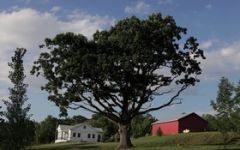Boundary Breaks No. 239 Dry Riesling 2015
-
James
Suckling


Product Details
Your Rating
Somm Note
Winemaker Notes
Professional Ratings
-
James Suckling
Still a bit closed but this is even more concentrated and has even more drive than the very impressive 2014 vintage of the same wine — but it's maybe also a shade less exotic in aroma. The whisker of grape sweetness is beautifully integrated. Better in 2018 or 2019, but capable of much longer ageing.
Other Vintages
2021-
James
Suckling -
Wine
Enthusiast -
Wine &
Spirits
-
James
Suckling -
Robert
Parker
-
Robert
Parker -
Wine
Spectator
-
Wine &
Spirits -
Wine
Enthusiast
-
Robert
Parker -
Wine
Enthusiast -
Wine &
Spirits -
James
Suckling
-
James
Suckling -
Wine
Enthusiast
-
Wine
Enthusiast
-
Wine
Enthusiast


The vineyard site is exceptional. There are 70 acres of open farmland that had previously been planted to row crops like corn and soybeans. The soils are characterized as “Cazenovia Silt Loam” which is tested at an optimal pH typical of calcareous soils. These soils are considered ideal for producing complex aromatic white wines.

Riesling possesses a remarkable ability to reflect the character of wherever it is grown while still maintaining its identity. A regal variety of incredible purity and precision, this versatile grape can be just as enjoyable dry or sweet, young or old, still or sparkling and can age longer than nearly any other white variety. Somm Secret—Given how difficult it is to discern the level of sweetness in a Riesling from the label, here are some clues to find the dry ones. First, look for the world “trocken.” (“Halbtrocken” or “feinherb” mean off-dry.) Also a higher abv usually indicates a drier Riesling.

Increasingly garnering widespread and well-deserved attention, New York ranks third in wine production in the United States (after California and Washington). Divided into six AVAs—the Finger Lakes, Lake Erie, Hudson River, Long Island, Champlain Valley of New York and the Niagara Escarpment, which crosses over into Michigan as well as Ontario, Canada—the state experiences varied climates, but in general summers are warm and humid while winters are very cold and can carry the risk of frost well into the growing season.
The Finger Lakes region has long been responsible for some of the country’s finest Riesling, and is gaining traction with elegant, light-bodied Pinot Noir and Cabernet Franc. Experimentation with cold-hardy European varieties is common, and recent years have seen the successful planting of grapes like Grüner Veltliner and Saperavi (from the Eastern European country of Georgia). Long Island, on the other hand, has a more maritime climate influenced by the Atlantic Ocean, and shares some viticultural characteristics with Bordeaux. Accordingly, the best wines here are made from Merlot and Cabernet Franc. The Niagara Escarpment is responsible for excellent ice wines, usually made from the hybrid variety, Vidal.
